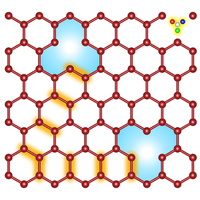Abstract
The Kitaev honeycomb model has attracted significant attention due to its exactly solvable spin-liquid ground state with fractionalized Majorana excitations and its possible materialization in magnetic Mott insulators with strong spin-orbit couplings. Recently, the -electron compound has shown to be a strong candidate for Kitaev physics considering the absence of any signs of a long-range ordered magnetic state. In this work, we demonstrate that a finite density of random vacancies in the Kitaev model gives rise to a striking pileup of low-energy Majorana eigenmodes and reproduces the apparent power-law upturn in the specific heat measurements of . Physically, the vacancies can originate from various sources such as missing magnetic moments or the presence of nonmagnetic impurities (true vacancies), or from local weak couplings of magnetic moments due to strong but rare bond randomness (quasivacancies). We show numerically that the vacancy effect is readily detectable even at low vacancy concentrations and that it is not very sensitive either to the nature of vacancies or to different flux backgrounds. We also study the response of the site-diluted Kitaev spin liquid to the three-spin interaction term, which breaks time-reversal symmetry and imitates an external magnetic field. We propose a field-induced flux-sector transition where the ground state becomes flux-free for larger fields, resulting in a clear suppression of the low-temperature specific heat. Finally, we discuss the effect of dangling Majorana fermions in the case of true vacancies and show that their coupling to an applied magnetic field via the Zeeman interaction can also account for the scaling behavior in the high-field limit observed in .
8 More- Received 22 July 2020
- Revised 19 November 2020
- Accepted 4 January 2021
DOI:https://doi.org/10.1103/PhysRevX.11.011034
Published by the American Physical Society under the terms of the Creative Commons Attribution 4.0 International license. Further distribution of this work must maintain attribution to the author(s) and the published article’s title, journal citation, and DOI.
Published by the American Physical Society
Physics Subject Headings (PhySH)
Popular Summary
A quantum spin liquid (QSL) is an exotic phase of matter in which the magnetic moments, or spins, remain jumbled even at zero temperature. Researchers are interested in how QSLs respond to disorder in the form of vacancies, impurities, and atomic-bond randomness, all of which are inevitable in real materials. This is important for studies of a growing number of magnetic materials that are believed to realize QSLs—in particular, for the QSL described by the celebrated “Kitaev model” consisting of spin-1/2 particles positioned on the vertices of a honeycomb lattice. This exactly solvable model has provided a solid theoretical test bed for understanding QSL properties, which can now be checked experimentally in several Kitaev candidate materials. Motivated by the experimental findings in the Kitaev material , we analyze how vacancies, or voids in the atomic lattice, impact the properties of a Kitaev QSL.
We show that introducing a small concentration of vacancies in the Kitaev model preserves most of the QSL behavior but leads to distinct changes in its low-energy properties. In particular, we show that while vacancy-induced low-energy behavior in the Kitaev QSL resembles that of graphene with site defects, there are fundamental differences between them due to the fractionalized nature of low-energy degrees of freedom in the Kitaev QSL.
Our results are important for understanding low-energy properties of magnetic materials proximate to other QSLs for which exact solutions are not available.



